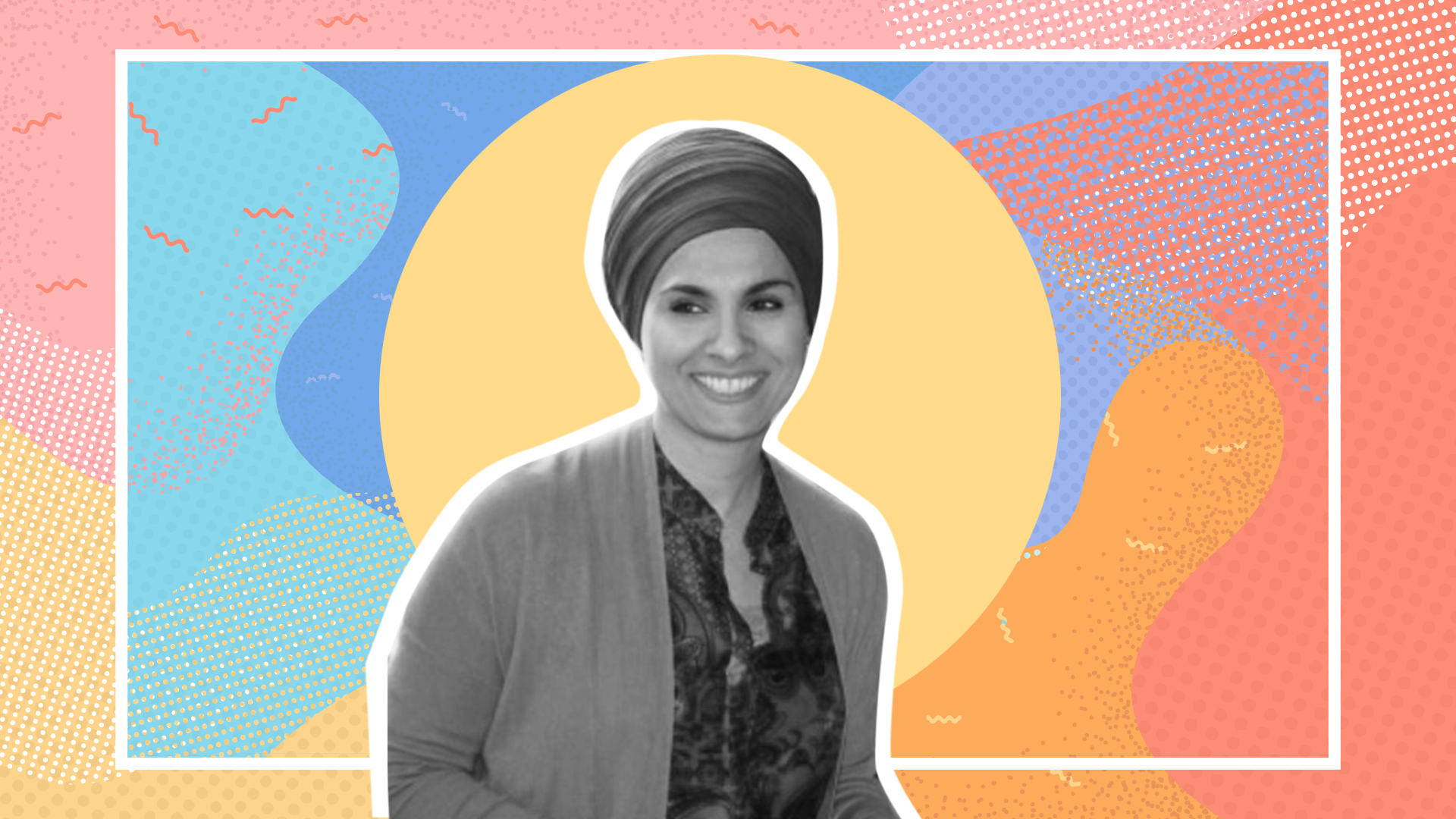A Sikh woman on being an unapologetic turban wearer, and why it's a powerful educational tool
We talked to Divinder Kaur, a Sussex teacher, about commitment—to her profession and her faith

In this mini-series, writer Laurie O'Garro talks to inspiring, marginalized women about the everyday hurdles they face. She reveals how they overcome them, and their aspirations for a more inclusive future.
Divinder Kaur is a British born Sikh who lives in Sussex. She proudly wears a turban and works as a teacher.
I met Divinder when I taught in a secondary school. I was her form tutor for five years, and the teacher she refers to in this interview is me. She has grown into an incredible woman who makes a difference in the lives of many children in her community.
Divinder on the positive difference education can make...
“My family has lived in England for three generations and I’m the eldest of my siblings. My parents dedicated their lives to bettering ours, with the aspiration of us going onto becoming successful adults. There was an unspoken hope in their eyes as we were growing up that we wouldn’t have to face the discrimination that they’d endured in their workplaces. My Punjabi-speaking parents wanted us to fit into British life without the difficulties they faced.”
“At school, we had a really inspiring Form Tutor who understood and grounded us. She motivated us and told us not to ever settle for second best. As I entered the adult world, more and more of her life lessons became relevant.”
How was an African-Caribbean teacher able to connect in such a meaningful way with her South Asian pupils?
“Upon reflection, I believe that this teacher connected with us because she understood what it was like to be marginalised. I believe she pre-empted the difficulties we would face as non-mainstream communities at that time and gave us insights into things not being as easy as we might expect. She took a ‘forewarned is forearmed’ approach, but not in a cynical or pessimistic way. She offered us a realistic way of looking at the world, whilst nurturing our ambitions. Her message was, ‘You can be anything you want to be, but understand there will be hurdles along the way, and you need to know how to conduct yourselves in situations where you are singled out for being different.’
Sign up for the woman&home newsletter
Sign up to our free daily email for the latest royal and entertainment news, interesting opinion, expert advice on styling and beauty trends, and no-nonsense guides to the health and wellness questions you want answered.
“While studying for my A levels, fate led me to work with a severely autistic child who was excluded from a mainstream school and was home-schooled in a programme tailored to his needs. This poignant life experience was a pivotal moment in my understanding of what I wanted to achieve in life: I needed to make a positive difference in the lives of children.”
My dastaar (turban) is a constant reminder of the need for education. I have the confidence to be unapologetic about who I am and what I represent
Divinder Kaur
Divinder on putting faith at the core...
“My Sikh identity was more visible towards the end of my time at university when I decided to wear my dastaar (turban). For me, this was how I was supposed to look; it was about my journey towards self-worth, and it was a natural progression. At the time, I didn’t give a second thought to people’s reactions to how I looked, and I didn’t believe it would hold me back professionally. Surely my credentials would speak for me and not the way I looked? My dastaar is the outward manifestation of my faith, and I can’t imagine my life otherwise.”
I wanted to know more about this confidence Divinder had in expressing her faith. What would her form tutor have thought?
“I think she’d have said, ‘Go ahead, be true to yourself, but understand it won’t be an easy ride.’”
Talking at children about acceptance isn’t the same as giving them a safe space to voice their opinions about what diversity and acceptance means
Divinder Kaur
Divinder on how people react to the 'woman in the Headdress'...
“I live in an area where turban-wearing Sikhs are a tiny community, so naturally my appearance is something new for many people, as they’ve never heard of Sikhs. My dastaar is a constant reminder of the need for education. I have the confidence to be unapologetic about who I am and what I represent.”
“Being described and referred to as ‘ the Sikh woman’ or ‘the woman with the headdress’ in situations where people don’t know me is normal. After all, I’ve chosen to be identified as a Sikh woman first and foremost. At school, children are so accepting.
"They’ll say to me, ‘What’s that on your head?’. I’ll tell them it’s my turban, and they’ll say, ‘Oh, okay.’ and then ask something equally interesting, like ‘So are you having chips today, Miss?’
“Children don’t ‘box’ people into differentiating categories. That level of unconditional acceptance is possible in society, yet somewhere along the way, it gets lost. What happens? There’s a lack of opportunity to ask questions... there’s just not enough time in the school day. There isn’t time to challenge preconceptions and prejudices… talking at children about acceptance isn’t the same as giving them a safe space to voice their opinions about what diversity and acceptance means to them. There’s so much learning that doesn’t happen organically and we need to talk about that.
I have consciously made the choice to challenge social norms and misconceptions. I’m prepared to engage, talk, educate and dispel
Divinder Kaur
Divinder on confounding expectations...
“I’m often met with disbelief when I tell people I’m the one in charge, in a professional capacity, but I’m actually becoming indifferent to it. The reason I’m okay with it is because I have consciously made the choice to challenge social norms and misconceptions. I’m prepared to engage, talk, educate and dispel.”
I asked Divinder if she finds the constant need to explain who she was tiring. “I’m acutely aware that microaggressions like this exist, but they don’t weigh me down or stop me from pursuing my purpose. I have an opportunity to make a difference and so I will.”
Divinder on the future...
Asked how she sees the future, Divinder replies, “We need to tap into the high thresholds of acceptance that children possess and build on that. We need to be the ones who model how to develop meaningful relationships with people. We need to be the ones who change the narratives that divide humanity.”
The desire to do this is particularly relevant in the wake of 9/11. Divinder has seen the Sikh community constantly having to defend themselves against accusations of being terrorists. “We’re no strangers to hate crime and inequality. Mainstream media have been instrumental in demonizing men with beards and turbans, whilst portraying women who look like me as oppressed. We’ve worked hard to get the message out that Sikhs have an unrelenting tradition of giving back to whichever community we find ourselves in.”
Nevertheless, Divinder remains hopeful: “Faith opens your mind to all creation and makes you sensitive to the world around you. It’s a catalyst that inspires growth and self-development. My identity is a vehicle that brings out the best in me. Wearing the dastaar is a constant reminder of my religious beliefs that holds me to account: Am I a good ambassador of my Sikh faith?”
◉ A disabled woman seeking equality for the 'unhealthy'
◉ A mixed-race woman on the everyday work of being Black
◉ How I'm a conscious parent to my black daughter
I end our conversation by asking Divinder to share one final message with readers. Without hesitating, she replies, “Ask questions! What’s there to lose from understanding something new?”
Laurie O'Garro is a conscious parent, teacher, String Artist, poet, writer and would-be author. She lives in London.
-
 Do you know what your stems are saying? These are the most popular flowers and what they symbolise
Do you know what your stems are saying? These are the most popular flowers and what they symboliseI break down different flowers and what they symbolise so that you can say more whilst speaking less with a truly beautiful bouquet
By Laura Honey
-
 Celebrities who built their looks around a simple, timeless white shirt
Celebrities who built their looks around a simple, timeless white shirtA white shirt should be in every woman's wardrobe - and these celebrities prove all the ways to expertly style one
By Jack Slater